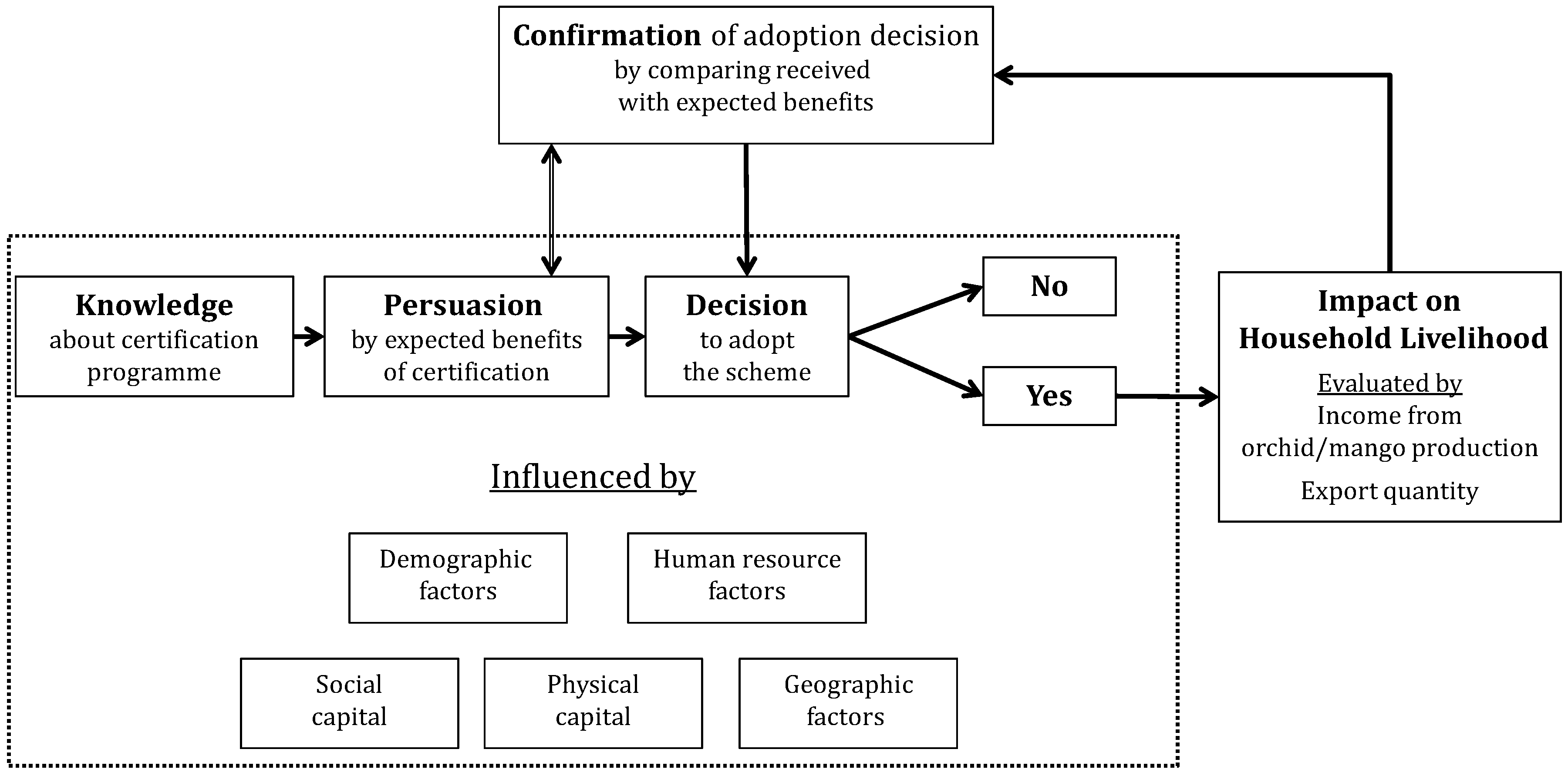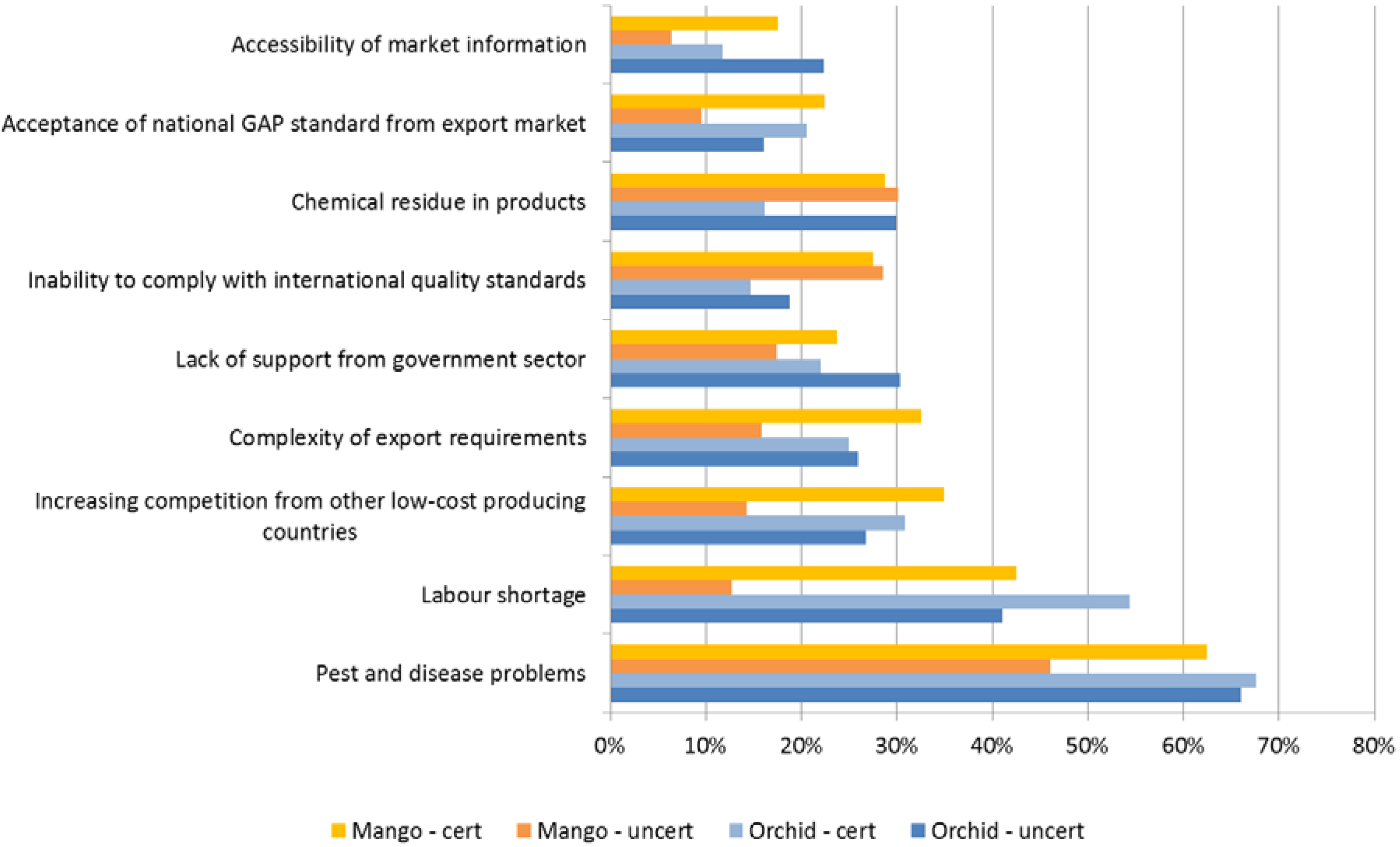1. Introduction
The demand for fresh horticultural products is continually rising, both in domestic and international markets [
1]. Consumers from industrialized countries, such as some countries in the European Union, desire the year-round availability of a variety of horticultural products including tropical fruits and flowers [
2]. In response to these trends, the interest in accessing these markets has significantly increased among producers and traders of horticultural products in developing countries. However, a more frequent occurrence of food safety problems and the rising health consciousness of consumers have led to an increasing demand for safe horticultural products [
3]. At the same time, consumers have increasingly paid attention to environmental concerns and the way food is being produced including its farming practices. In addition, there was a gradual shift from concerns about only edible goods to other agricultural goods, such as flowers or timber products.
The scope of national legislation in many developing countries is considered insufficient for transnational trade [
4]. Thus, trade liberalization and globalization in the last decades have resulted in institutional adaptation, driving the development of internationally recognized standards and regulatory schemes [
5]. Standards and certification systems which define whether products have been produced in an environmentally-friendly way or whether they are free of pesticides are considered as viable solutions to sort out the problem of information asymmetry and reduce transaction costs among different actors in the supply chain [
6]. Certification systems also help to increase the communication between actors in the supply chain on production processes. Similarly, labeling is a form of directly conveying information of quality aspects of the product to end consumers [
7].
In global horticultural value chains, private actors, such as big supermarkets and/or retail chains, play an increasingly large role. They have become rule-setters and often take the initiative to ensure certain safety and quality levels and create market demand for exotic produce [
8]. Good Agricultural Practices (GAP) are food safety and quality standards of on-farm and post-farm activities, encompassing a set of management regulations of how to produce environmentally friendly and socially-acceptable products [
9]. GAPs are the most important standards in global horticultural value chains and they have been especially promoted by the private sector initiative GLOBALG.A.P. However, the trend towards private GAP standards still poses many challenges as compliance can be a rather complex task; it also involves high investment costs and additional skilled laborers. As a result, producers without appropriate financial resources are not likely to adopt those private standards [
10]. In contrast to private GAP standards, public GAP certification schemes are introduced by governments in export-oriented emerging nations. They are based on their own quality and safety standards to position themselves in competitive global markets [
11]. They can also be an alternative for export-oriented producers due to lower cost of compliance and lower complexity of its schemes. Besides the easier access for the individual producers, public GAP standards can be a way of adding value to the country’s agricultural goods for export as a whole [
12]. The empowerment of public standards is often the only necessary step to unleash the potential of exporting horticultural goods [
13,
14]. To enhance export growth, some developing countries have already successfully upgraded their export sectors through better compliance with the increasing public food standards in global markets [
15].
The Thai government follows the long-term strategy to expand Thai exports of horticultural products [
16]. Thai authorities have actively promoted voluntary public Q-GAP standards (Q denotes quality) as part of their strategy to maintain and expand export markets. The aim of this scheme is to assure product quality and compliance with certain environmental and social regulations [
3,
16]. A full implementation of the national GAP program (Q-GAP) started in 2004, as an important component in the road map of food safety policy [
16,
17]. The national Q-GAP standards contain eight principles (water source, cultivation site, use of agro-chemicals, product storage and on-site transportation, data records, pest-free products, quality management, harvesting and post-harvest handling) and to date emphasize pesticide control and Maximum Residue Limits (MRLs) monitoring. Producers are allowed to label their produce with the golden Q-mark if they comply with all required principles. The entire certification process is carried out by government agencies [
16]. In this regard, costs of compliance, specifically for training, external auditing and the annual certification fee, are mostly covered by government agencies and are thus free for producers. However, producers still have to cover other costs of upgrading their facilities (i.e., farm infrastructure and equipment such as storage room for pesticides) and buying protective clothing for farm workers [
10].
While the number of certified producers in the horticultural food sector is growing, recently the non-food sector (i.e., flowers) has shown a reduction in Q-GAP adoption rates [
18]. It is therefore questionable whether producers do benefit from complying with this public scheme. However, only a small number of in-depth analyses exist in the context of public GAP standards and for the horticulture sector in general. Up to the point of this study, no impact analysis from a public GAP certification scheme on income could be found. This study therefore aims at assessing the determinants of adopting a public GAP standard among producers of horticulture products and the standard’s impact on producers’ income and export shares by focusing on mango and orchids as representative for food and non-food horticultural products.
Orchid and mango were chosen due to their economic importance and high export potential to overseas markets [
19]. The advantage of comparing orchids and mangoes is that they are rather similar in terms of their presence in Thai domestic and international markets. While they are both rather common products in domestic markets bought by everyone, they are also exported in large quantities [
19]. This allows us to draw conclusions from the results focusing only on the aspect of edible vs. inedible horticultural crops. The problems that producers of edible horticultural products face when they want to enter the export market are quite different to the ones that producers of inedible goods like flowers face. Food safety, for example, is a major concern for producers of fresh edible horticultural products, while for inedible crops quality aspects, such as the appearance, are more important. It is thus questionable if producers of these two types of products have similar adoption patterns for the same certification program. We expect that the standards in the certification program, which are identical for mango and orchid producers, will have different effects because of the different needs among producers and the demand of consumers of edible and inedible horticultural crops.
This study will help Thai government officials and other actors in the Q-GAP administration to evaluate the success of the program and seek strategies to enhance it. Next to the Thai government, all governmental and non-governmental agencies which design or plan to design certification schemes are expected to benefit from this study. They will be more aware about the factors that drive producers to adopt certain schemes but they will be also informed about the impact of the schemes in terms of income and export facilitation.
The paper is structured as follows. The next section gives an overview of the current adoption and impact literature for standards and certification in horticultural products, followed by the conceptual framework. Data collection and methodology are presented in the third section. The last section concludes with a summary of the main results of the study and highlights the need for further empirical research.
5. Conclusions
The present study evaluates the impact of voluntary public GAP standards on income and export shares of mango and orchid producers. Based on primary data from 400 certified and non-certified orchid and mango producers from the major exporting areas in Thailand, the binary probit model estimations show that the better-off orchid and mango producers in terms of education, physical and social capital tend to comply with Q-GAP standards. Compared to previous literature, there is no difference between the characteristics of horticultural adopters of private GAP schemes and this public GAP scheme. This study focuses on producers with export-oriented crops. Further study is necessary to evaluate the situation for the domestic market in order to get a full picture of the adoption patterns of Q-GAP.
The results of the impact models indicate that mango producers who comply with Q-GAP standards obtain a significantly higher net income than non-certified ones. For orchid producers, however, certification status did not have any influence on export quantities or income. It seems like the program is not designed to fit the needs of orchid producers. The Q-GAP certification focuses on pesticide reduction and compliance to international standards [
3]. Our data shows that while these are indeed obstacles to access the export market for mango producers, these points are not an issue for orchid producers. They perceive the inability to comply with international standards as the least of their problems and none of the orchid producers perceived product safety or environmental protection as an advantage of the Q-GAP program. Instead, major obstacles to enter the export market, such as shortage of labor and pests and diseases on the product, are further worsened by the standard’s requirements of record keeping and pesticide control. Nevertheless, a demand for excluding non-edible crops from Q-GAP certification might be premature. The case of VietGAP shows that producers actually gain from pesticide reduction because they significantly reduce the loss of income due to health hazards from pesticide handling [
29]. This and the environmental benefits to reduce and ban certain pesticides are good reasons to continue the promotion of GAP standards in non-edible crops as well.
Conclusively, if Q-GAP was to be successful for non-edible horticultural crops, the certification needs to provide an additional value beyond product safety, which by itself is currently not remunerated by the buyers in international markets. The promotion of health benefits of following this standard for the farmer themselves could be one possibility to increase acceptance. Furthermore, since in the long run, Q-GAP seeks to be benchmarked to other international standards such as ASEAN-GAP or GLOBALG.A.P., producers already implementing this standard now may have an advantage in the future.
The major limitation of this study is that, so far, only cross-sectional data is available to gain insights into the certification’s impact on producers’ income. Even though two different established methods for impact analysis have been applied to check for robustness of the results, variation over time is not visible. An analysis based on panel data could reveal the real magnitude of impact and control better for hidden bias. While the analysis at hand showed clear differences between edible and non-edible horticultural crops regarding the adoption decision and impact of Q-GAP, further research is needed to understand the impacts of certification on other crops such as fresh vegetables for export. Furthermore, the mechanism as to why Q-GAP certified mango producers achieve higher income could be investigated with a follow-up study. Does Q-GAP enable the producers to access the high-value export market through better farm management and product safety, or did they adopt the certification simply to continue exporting, because exporters started to demand Q-GAP? Further research should also extend to other stakeholders in the value chain to understand their perception and expectations of Q-GAP, which could help the Thai government to ameliorate the scheme’s performance further.









